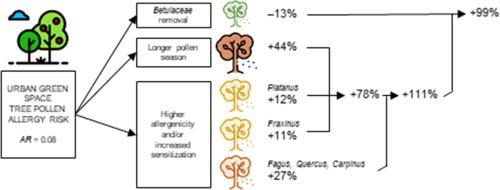当前位置:
X-MOL 学术
›
Landsc. Urban Plan.
›
论文详情
Our official English website, www.x-mol.net, welcomes your feedback! (Note: you will need to create a separate account there.)
Tree pollen allergy risks and changes across scenarios in urban green spaces in Brussels, Belgium
Landscape and Urban Planning ( IF 9.1 ) Pub Date : 2021-03-01 , DOI: 10.1016/j.landurbplan.2020.104001 Raf Aerts , Nicolas Bruffaerts , Ben Somers , Claire Demoury , Michelle Plusquin , Tim S. Nawrot , Marijke Hendrickx
Landscape and Urban Planning ( IF 9.1 ) Pub Date : 2021-03-01 , DOI: 10.1016/j.landurbplan.2020.104001 Raf Aerts , Nicolas Bruffaerts , Ben Somers , Claire Demoury , Michelle Plusquin , Tim S. Nawrot , Marijke Hendrickx

|
Abstract Urban green spaces may improve human health and well-being. However, green spaces may also emit allergenic pollen and these may trigger asthma, allergic disease, and respiratory infections. How allergy risks in green spaces may be modified by environmental change is still not widely understood. This study analyzed tree inventory data of 18 urban green spaces (5940 trees; 278 taxa; 93 ha) in the Brussels Capital Region, Belgium. We investigated present tree pollen allergy risk (AR) and changes in AR driven by changes in tree species composition, allergenic potential and pollen season duration. AR was estimated by calculating the allergenicity index I UGZA (range 0–1, 1 worst) for the present situation and 13 scenarios. The average AR was 0.08 (SD 0.05; range 0.002–0.17). The AR increased by 11–27% in increased allergenic potential scenarios, and by 44% in the increased pollen season duration scenario. Preventive removal of birch, hazel and alder reduced the AR by 13%. The AR increased by 99–111% in combined scenarios with and without preventive removal of the main allergenic taxa. These findings indicate that tree pollen allergy risks could considerably rise when ongoing environmental changes lead to a combination of longer pollen seasons, increased pollen allergen potency, and increased sensitization for one or more species. The preventive removal of the main allergenic tree species cannot sufficiently counter allergy risks caused by other species and that are amplified by environmental change, highlighting the importance of careful tree species selection in urban green space policy and planning.
中文翻译:

比利时布鲁塞尔城市绿地中树花粉过敏风险和不同场景的变化
摘要 城市绿地可以改善人类健康和福祉。然而,绿色空间也可能散发出过敏性花粉,这些花粉可能引发哮喘、过敏性疾病和呼吸道感染。环境变化如何改变绿色空间中的过敏风险仍未得到广泛了解。本研究分析了比利时布鲁塞尔首都地区 18 个城市绿地(5940 棵树;278 个分类群;93 公顷)的树木清单数据。我们调查了目前树木花粉过敏风险 (AR) 和由树种组成、过敏潜力和花粉季节持续时间的变化驱动的 AR 变化。AR 是通过计算当前情况和 13 种情景的过敏性指数 I UGZA(范围 0-1,1 最差)来估计的。平均 AR 为 0.08(SD 0.05;范围 0.002–0.17)。AR 在潜在过敏原增加的情况下增加了 11-27%,在花粉季节持续时间增加的情况下增加了 44%。桦树、榛树和桤木的预防性去除将 AR 降低了 13%。在有和没有主要过敏性分类群的预防性去除的组合情况下,AR 增加了 99-111%。这些发现表明,当持续的环境变化导致花粉季节延长、花粉过敏原效力增加以及对一种或多种物种的敏感性增加时,树木花粉过敏风险可能会大大增加。主要致敏树种的预防性清除不能充分应对由其他物种引起的过敏风险以及因环境变化而放大的过敏风险,突出了谨慎选择树种在城市绿地政策和规划中的重要性。在花粉季节持续时间增加的情况下增加了 44%。桦树、榛树和桤木的预防性去除将 AR 降低了 13%。在有和没有主要过敏性分类群的预防性去除的组合情况下,AR 增加了 99-111%。这些发现表明,当持续的环境变化导致花粉季节延长、花粉过敏原效力增加以及对一种或多种物种的敏感性增加时,树木花粉过敏风险可能会大大增加。主要致敏树种的预防性清除不能充分应对由其他物种引起的过敏风险以及因环境变化而放大的过敏风险,突出了谨慎选择树种在城市绿地政策和规划中的重要性。在花粉季节持续时间增加的情况下增加了 44%。桦树、榛树和桤木的预防性去除将 AR 降低了 13%。在有和没有主要过敏性分类群的预防性去除的组合情况下,AR 增加了 99-111%。这些发现表明,当持续的环境变化导致花粉季节延长、花粉过敏原效力增加以及对一种或多种物种的敏感性增加时,树木花粉过敏风险可能会大大增加。主要致敏树种的预防性清除不能充分应对由其他物种引起的过敏风险以及因环境变化而放大的过敏风险,突出了谨慎选择树种在城市绿地政策和规划中的重要性。榛子和桤木将 AR 降低了 13%。在有和没有主要过敏性分类群的预防性去除的组合情况下,AR 增加了 99-111%。这些发现表明,当持续的环境变化导致花粉季节延长、花粉过敏原效力增加以及对一种或多种物种的敏感性增加时,树木花粉过敏风险可能会大大增加。主要致敏树种的预防性清除不能充分应对由其他物种引起的过敏风险以及因环境变化而放大的过敏风险,突出了谨慎选择树种在城市绿地政策和规划中的重要性。榛子和桤木将 AR 降低了 13%。在有和没有主要过敏性分类群的预防性去除的组合情况下,AR 增加了 99-111%。这些发现表明,当持续的环境变化导致花粉季节延长、花粉过敏原效力增加以及对一种或多种物种的敏感性增加时,树木花粉过敏风险可能会大大增加。主要致敏树种的预防性清除不能充分应对由其他物种引起的过敏风险以及因环境变化而放大的过敏风险,突出了谨慎选择树种在城市绿地政策和规划中的重要性。这些发现表明,当持续的环境变化导致花粉季节延长、花粉过敏原效力增加以及对一种或多种物种的敏感性增加时,树木花粉过敏风险可能会大大增加。主要致敏树种的预防性清除不能充分应对由其他物种引起的过敏风险以及因环境变化而放大的过敏风险,突出了谨慎选择树种在城市绿地政策和规划中的重要性。这些发现表明,当持续的环境变化导致花粉季节延长、花粉过敏原效力增加以及对一种或多种物种的敏感性增加时,树木花粉过敏风险可能会大大增加。主要致敏树种的预防性清除不能充分应对由其他物种引起的过敏风险以及因环境变化而放大的过敏风险,突出了谨慎选择树种在城市绿地政策和规划中的重要性。
更新日期:2021-03-01
中文翻译:

比利时布鲁塞尔城市绿地中树花粉过敏风险和不同场景的变化
摘要 城市绿地可以改善人类健康和福祉。然而,绿色空间也可能散发出过敏性花粉,这些花粉可能引发哮喘、过敏性疾病和呼吸道感染。环境变化如何改变绿色空间中的过敏风险仍未得到广泛了解。本研究分析了比利时布鲁塞尔首都地区 18 个城市绿地(5940 棵树;278 个分类群;93 公顷)的树木清单数据。我们调查了目前树木花粉过敏风险 (AR) 和由树种组成、过敏潜力和花粉季节持续时间的变化驱动的 AR 变化。AR 是通过计算当前情况和 13 种情景的过敏性指数 I UGZA(范围 0-1,1 最差)来估计的。平均 AR 为 0.08(SD 0.05;范围 0.002–0.17)。AR 在潜在过敏原增加的情况下增加了 11-27%,在花粉季节持续时间增加的情况下增加了 44%。桦树、榛树和桤木的预防性去除将 AR 降低了 13%。在有和没有主要过敏性分类群的预防性去除的组合情况下,AR 增加了 99-111%。这些发现表明,当持续的环境变化导致花粉季节延长、花粉过敏原效力增加以及对一种或多种物种的敏感性增加时,树木花粉过敏风险可能会大大增加。主要致敏树种的预防性清除不能充分应对由其他物种引起的过敏风险以及因环境变化而放大的过敏风险,突出了谨慎选择树种在城市绿地政策和规划中的重要性。在花粉季节持续时间增加的情况下增加了 44%。桦树、榛树和桤木的预防性去除将 AR 降低了 13%。在有和没有主要过敏性分类群的预防性去除的组合情况下,AR 增加了 99-111%。这些发现表明,当持续的环境变化导致花粉季节延长、花粉过敏原效力增加以及对一种或多种物种的敏感性增加时,树木花粉过敏风险可能会大大增加。主要致敏树种的预防性清除不能充分应对由其他物种引起的过敏风险以及因环境变化而放大的过敏风险,突出了谨慎选择树种在城市绿地政策和规划中的重要性。在花粉季节持续时间增加的情况下增加了 44%。桦树、榛树和桤木的预防性去除将 AR 降低了 13%。在有和没有主要过敏性分类群的预防性去除的组合情况下,AR 增加了 99-111%。这些发现表明,当持续的环境变化导致花粉季节延长、花粉过敏原效力增加以及对一种或多种物种的敏感性增加时,树木花粉过敏风险可能会大大增加。主要致敏树种的预防性清除不能充分应对由其他物种引起的过敏风险以及因环境变化而放大的过敏风险,突出了谨慎选择树种在城市绿地政策和规划中的重要性。榛子和桤木将 AR 降低了 13%。在有和没有主要过敏性分类群的预防性去除的组合情况下,AR 增加了 99-111%。这些发现表明,当持续的环境变化导致花粉季节延长、花粉过敏原效力增加以及对一种或多种物种的敏感性增加时,树木花粉过敏风险可能会大大增加。主要致敏树种的预防性清除不能充分应对由其他物种引起的过敏风险以及因环境变化而放大的过敏风险,突出了谨慎选择树种在城市绿地政策和规划中的重要性。榛子和桤木将 AR 降低了 13%。在有和没有主要过敏性分类群的预防性去除的组合情况下,AR 增加了 99-111%。这些发现表明,当持续的环境变化导致花粉季节延长、花粉过敏原效力增加以及对一种或多种物种的敏感性增加时,树木花粉过敏风险可能会大大增加。主要致敏树种的预防性清除不能充分应对由其他物种引起的过敏风险以及因环境变化而放大的过敏风险,突出了谨慎选择树种在城市绿地政策和规划中的重要性。这些发现表明,当持续的环境变化导致花粉季节延长、花粉过敏原效力增加以及对一种或多种物种的敏感性增加时,树木花粉过敏风险可能会大大增加。主要致敏树种的预防性清除不能充分应对由其他物种引起的过敏风险以及因环境变化而放大的过敏风险,突出了谨慎选择树种在城市绿地政策和规划中的重要性。这些发现表明,当持续的环境变化导致花粉季节延长、花粉过敏原效力增加以及对一种或多种物种的敏感性增加时,树木花粉过敏风险可能会大大增加。主要致敏树种的预防性清除不能充分应对由其他物种引起的过敏风险以及因环境变化而放大的过敏风险,突出了谨慎选择树种在城市绿地政策和规划中的重要性。



























 京公网安备 11010802027423号
京公网安备 11010802027423号